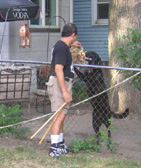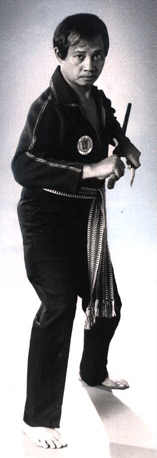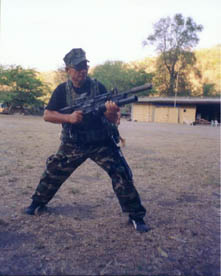The In-Depth of Pekiti-Tirsia Kali
How effective it is or How effective it was
by Grand Tuhon Leo Gaje Jr.

Let me open the Floodgates of understanding and knowing what Filipino Fighting art is all about. At the age of six to nine years old, my grandfather Grand Tuhon Conrado B. Tortal with his brothers and friends called him (Dadoy) started to bring me to a daily lecture about the family, how I was born with a twin sister, how I was brought to Negros Island from Bicol Province in Luzon which during those times, traveling by boat takes at least five days, How after birth I came out without life, then the Doctor dip me into warm and cold water until I was able to cry. How I grew with them without the father since my mother died a week after I was born with my twin sister. How they sacrifice as Grand Lolo and Grand Lola in caring and loving with the expectation that one day I will be a man to take the responsibility in administering the 120 hectares of farmlands and to inherit the treasure of knowledge in the art that is Pekiti-Tirsia System.
For my grandfather his motivation was for me to learn every piece of training from the Philosophical values to logic and to reasons, from the fundamental frameworks of Pekiti-Tirsia as a system and to reach the highest geometrical equations reinforced by the art of metaphysics. My grandfather was a very educated and learned person, at grade seven he was already a teacher in the high school, he spoke very fluent Spanish, very conversant in Latin, very grammatical in English Language and very selective in his conversation using the Original Ilongo dialect. His commanding personality penetrates to one’s senses, his eyes constantly focused to a person’s face without deviating to any direction when he was on a discussion or even a mere friendly conversation. His hands were always in a loading position in front of his lap while in sitting position, while standing his right or left hand is moving across his chest when he explains important points about the subject but never he drop his arms along side of the body. He never allowed anyone to be at his back, he always positioned himself with his back against the wall, or coconut tree or anything that was solid. His remarkable achievement in his life career was when he was selected to be The First Chief of Police in the town of Victorias, now a City in the early 30’s.
Victorias area during those early days was noted for notorious (sacadas) cane cutters working in the Haciendas. Victorias was famous for the best white sugar exported all over the world. The biggest Sugar Mill in the Philippines today is Victorias Milling Company. As Chief of Police, he instituted strict discipline disallowing any Police man to sleep while on duty, strictly no smoking and drinking while on duty, no gambling while on duty or out of duty, when reporting for duty, the police officer must wear clean well pressed Khaki Uniform. Two times a week they were forced to train, police techniques especially the use of the Police Baton, arrest methods, but with emphasis on defensive tactics against the (Espading) a cane cutter with special thin wide blade 14 inches long. The notorious Gangs used the (Espading) to attack their rival gangs coming from another province to work in the Sugar cane fields (Haciendas)
The daily routine that was a form of discipline was for me to stand on the long table and do the footwork in form of forward triangle and reverse triangle. Doing my execution he watched me and if I falter he bit my foot with his horse whip. This is an initial conditioning that work into my system and only when I was at the age of nine, I had to do slashes and thrust without even knowing the numbering system and only at this age I had my first lesson with the (blade) talibong as my first conditioning weapon. Just to feel and be able to appreciate the sharpness of the blade. The lesson was tough because you have to perform those routines in an open area where the sun and the grasses are your only friends. I have to stand against the heat of the sand and to be able to move using the Footwork against the tall grasses (cogon) and other small trees around. It was a complete simulation of combat fighting.

The rattan stick and the Bahi hardwood became the substitute of the real blade. Transferring the familiarization of the weapon from a round rattan to flat blade made the hand adjusted to the slash and thrust without difficulty. As the years of training started to roll, the techniques became sophisticated and intricate. After learning the fundamentals in the different angulations and triangulations in the execution of the blades. The execution of each techniques to be applied as a counter offense and re-counter offense using the cross methods accelerates to higher degree of application and that technical sparring becomes a requirement for higher learning. The following structures are the basis of learning process and mastery training.
To inculcate the full and complete knowledge of the Kali philosophy and understanding of its uses. To discipline both mind and physical body the essence of preservation, preparation and technical skill with mastery of what is blade combat fighting. Physical conditioning to include Road Work, Jogging with the Kalis, leg conditioning, footwork, squatting high and low exercise, Body shifting, endurance training, Drop and Back Roll with 50 repetitions, push ups in several repetitions while the knuckles are touching the ground. Grabbing the Kalis, slashes conditioning exercises with fast movements from different angles of attacks counter attacks thrust and counter thrust, power blows, bridging strikes. Mastering the CONTRA TIRSIA DOBLA DOZ is the ultimate goal in the Pekiti Tirsia System. It encompasses all the major intricate techniques that are useful in combat.
On the higher mastery, blade works with double kalis. Kalis and the Daga, Daga Vs. Daga. Ranging and bridging principles with simulated attacks are the major conditioning training, The technical sparring accelerates the proficiency level and in close quarter techniques, the application of in/out offensive / counter offensive movements are of great importance. How long will for one to be really knowledgeable and skillful in the art. In theory, it can be absorbed if the principles are explained structure by structure. But to put into skill work how the system operates, it will take a long time.
In my experience five years on a continuing process it can produce skillful fighter depending on the mentality of the person and the proper understanding of what is real and unreal. To be a real fighter, it takes a different breed of people, it counts most in the bloodline that connects the persons ability to absorb. If his father or grandfather or grandfather’s father was a great fighter and had fought several wars, including his cousins, uncles before his father, then you can trace the lineage of how a great fighter he is.
Pekiti-Tirsia as a system is complete by itself. By the operation of the theory as a fighting art of Filipino origin the techniques that are in the Pekiti-Tirsia are the products of accumulated knowledge gained by our great ancestors long before the coming of the Spaniards in the Philippines. Since the art of Kali is Malay oriented fighting art and even the word “Kali” is a Malay word. The compilation of different fighting experiences were sorted out and the best technology was formulated by our great ancestors to fit into the proper time. Just as Lapu-Lapu killing Ferdinand Magellan without first using the kampilan. The body armor worn by Ferdinand Magellan didn’t stop Datu Lapu-Lapu to use the hardened wooden Bahi as his first line of strategy to smash Magellan’s armor including the head. It was then Magellan lost his senses then Lapu Lapu chopped his head with the use of the Kampilan.
The Spaniards, the Americans and the Japanese had all one thing to say. The Filipino Fighting art was very effective and the Filipino warriors were gifted Fighters because they were given the strongest tool to fight and that was the Filipino Kali Philosophy, (one believes in life not death, one believe in success not failure, one believes in good health not sickness.) If there is any Martial Arts in the World today that can be more factual in terms of effectively with track records with fighting capabilities, it is the Filipino Fighters and the Fighting Art itself had remarkable significant history to recall.
1521 – Lapu-Lapu (a Filipino Chieftain) in the Island of Mactan, Cebu killed Ferdinand Magellan in the Battle of Mactan. Using the Art of Kali. Philippine Spanish revolution, Spain lost the revolution by selling the Filipinos to the Americans in the Treaty of Paris in 1889. The Philippine American War, the US Army forced the development of (45 Caliber pistol) with knocking power to stop and knock out Filipino Bolo Fighters fighting against the American in 1911.
The Japanese Imperial Forces occupied the Philippines and declared that the American will only find grasses and trees, because they will wipe out all the Filipinos. It took four months for the Japanese Imperial Forces to completely control and occupy the Philippines after the surrender of General Wainwright of the United States Armed forces.
The Filipino Guerillas fled to the mountains and continued fighting the Japanese using the Filipino Kalis as the only means of offensive weapons using the Filipino Guerilla tactics (evasion and escape strategy). For two years after the defeat of the Americans in the Philippines. Filipino Bolo Fighters maintained the battle against the Japanese Imperial Forces made possible for the return of General Douglas Mc Arthur as he promised “I shall return”. He caught the Japanese Armada in the Philippine Sea while living for Australia. The Japanese Armada was defeated and made to surrender. These are the major records how the Kali art was very useful to the United States Armed Forces and to the Filipino people that made possible the preservation of democracy in the Far East.

How depth is the Pekiti-Tirsia System? The Advanced Studies, Research and Development, a division of the Pekiti-Tirsia, Philippines Inc. had extensively made an inward program since 1989 by making comparative analysis in relation to the authenticity of the Malay fighting arts known to be Indonesian Penjak Silat, Malaysian BerSilat, Thailand Kabre-Kabrang, MuayThai, Philippines art of Kali. The result of this research had intriguing facts. Long before the Philippines got its name from King Philip of Spain as he named it after Ferdinand Magellan who died in the Battle of Mactan, the Philippine Archipelagos of 7,100 was once belong to the Indonisus with a total Archipelagos of 13,669 with more or less 20,769 islands. This is proven to the fact that the languages were observed with close relationship in spelling, pronunciation and meaning like the word “sakit” means (pain), “siko” (elbow), “mata” (eyes) “sipa” (kick) etc. These words are found in Indonesian (Bahasa Indonesia) and the Malay language of Malaysia which is also found in Filipino Language.
The Art of Silat of both countries, Indonesia and Malaysia have similarities with Filipino Kali in terms of techniques and training development have parallelism. In the Philippines, our research continues to progress as to the relationship of the kali as a Healing art, Herbology and metaphysics. This we found today that to authenticate the art, the grand old men that are still alive who had preserved the Art and who lives in the hinterlands can manifest the real truth, that Filipino Fighting Art has been used as a major line of defense against aggressors and as traditions the Bolo / Kalis is symbolic in all activities of the Filipino Families. It is the art of complete fluidity and smoothness of movement and the intercrossing of angulations and triangulations in rapid succession of slashes and thrusts makes the Filipino Fighting Art effective as it is and effective as it was.
